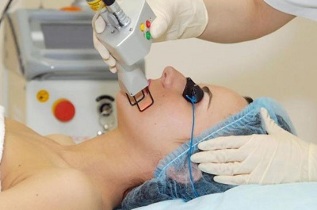In his youth, the facial skin looked smooth, young and firm, despite the health condition and the lack of cosmetic care. Over the years, its appearance gradually changes: first, the pleasing color disappears and the first wrinkles appear, then the spider veins, age spots and deep folds. Each change shows that the skin is aging. When conventional masks stop working, more powerful treatments come to the rescue, one of which is laser facial rejuvenation.
The advantage of fractional photothermal (this is its second name) is completely safe and highly effective in removing wrinkles and other defects. This procedure is a softer alternative to surgery or injection.
laser skin rejuvenation technologyWhat causes skin aging? There are several main reasons:
- impairment of metabolism; Delayed or incomplete waste disposal
- ;
- impaired development of cells;
- reduces the transfer of nutrients to cells.

Of course, it is not possible to initiate the reverse process of cell regeneration, but there is still a chance of activating the "sleeping" cells. For this, laser facial rejuvenation is used. After the heat treatment, the viable cells are activated, and the weak cells die completely, making room for more powerful samples. In a nutshell, the cell composition of the skin is renewed.
The quality and speed of the restoration depends on the diameter of the laser beam. Its thickness should be less than 200 microns. Fractional heat improves the effectiveness of laser treatment: instead of a single beam, multiple microscopic beams are impacted on the skin's surface, as if forming a mesh. Local areas are innovations in laser technology application. They help not touch healthy skin areas, thus contributing to early recovery.
fractional laser rejuvenation typesMuscle rejuvenation and lifting occurs through the use of two effective exposure methods, which differ in some of the characteristics of laser use.
- Treats the entire skin surface
Its main function is to evaporate the upper cells of the epidermis. The visible surface microscopic areas are removed, causing a lifting effect - the skin appears to stretch. As a result, the first sign of aging disappears - a mesh of fine wrinkles.
- Skin surface contact method
It works on the deeper, lower layers of the dermis and epidermis without affecting the top area. In this way, it is recommended to tackle the profound problems associated with irreversible skin aging. With the help of a laser, a new membrane skeleton is built, metabolism is activated, collagen production improves, resulting in younger looking skin from the inside. x / p>
Both of these methods are aimed at a local treatment, i. e. the surrounding skin is not affected - this is necessary for a quick and complete skin recovery. In fact, fractional laser facial rejuvenation can be called thermal shock, which renews the growth of healthy cells.
The combination of both methods allows you to achieve maximum results due to the dual healing impulse from the outside and from the inside. This technique is performed in many modern clinics with laser equipment.
Procedure and result
The advantage of laser skin treatment is that it is painless, which is an attractive factor for people with a fear of pain. The process itself is divided into several stages.
- Surface anesthesia, after which the patient feels no pain but only a slight tingling sensation in the treatment area. Anesthetic composition was applied immediately before the training session.
- Performs a session using a special device, based on the use of a fractional laser. Session duration within an hour, although the exact time depends on the number of zones treated.
- Applying skin regenerative cream.
- Consult a skincare professional
It will take about a week for the skin to update again. This is a fairly short period of time compared to, such as surgery.
During the first two days, the face is still swollen, then a red rash develops, after which the skin begins to peel off - the release of dead cells begins. They will be replaced with young, healthy cells, giving the face a fresh, youthful look.
Specifies the
fractional photothermalMost women and some men are no exception, take good care of yourself, so not only partial facial rejuvenation becomes popular but also laser photothermal methods forother parts of the body.
Usually, patients reach out if they need it:
- restores the skin to the whole body or some areas of the skin, especially visible;
- removes the capillary network and pigment;
- reduces pores;
- delete scars, stretch marks, scars;
- whitens skin;
- smooths or removes facial wrinkles;
- rejuvenates hands, chest, neck;
- upgrade, update skin texture.
Contraindicated with
procedureEach salon procedure has its own general and specific contraindications, laser facial treatments are no exception.
Thus, procedures using fractional lasers are prohibited for patients with any of the following diagnoses:
- Consequently
- lacks immunity - frequent infectious diseases;
- pregnancy, lactation;
- dermatology in the treatment area;
- scar;
- cancer;
- chronic blood disease, diabetes mellitus;
- herpes

Also, postpone laser rejuvenation if you have been taking retinoids for six months before your session and if your body has a tanned skin.
Every woman of any age wants to have beautiful, healthy skin
There are some diseases where the procedure can be performed but only after consulting a specialist, therefore, before any procedure, it is necessary to consult a doctor. However, if you identify one or more of the contraindications, you should endure a certain amount of time until complete recovery or begin a state when your body is ready for a laser. The procedure itself is safe, but if there is an illness it can cause it to grow.
If you can't use a laser, you should choose other methods to remove signs of skin aging, for example Botox injections or hyaluronic acid.














































































